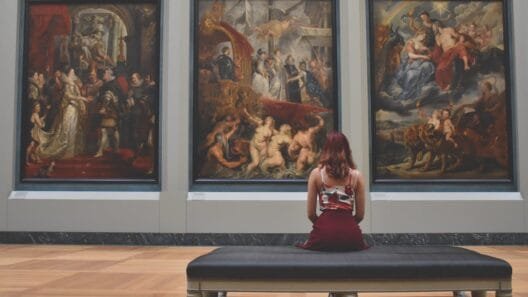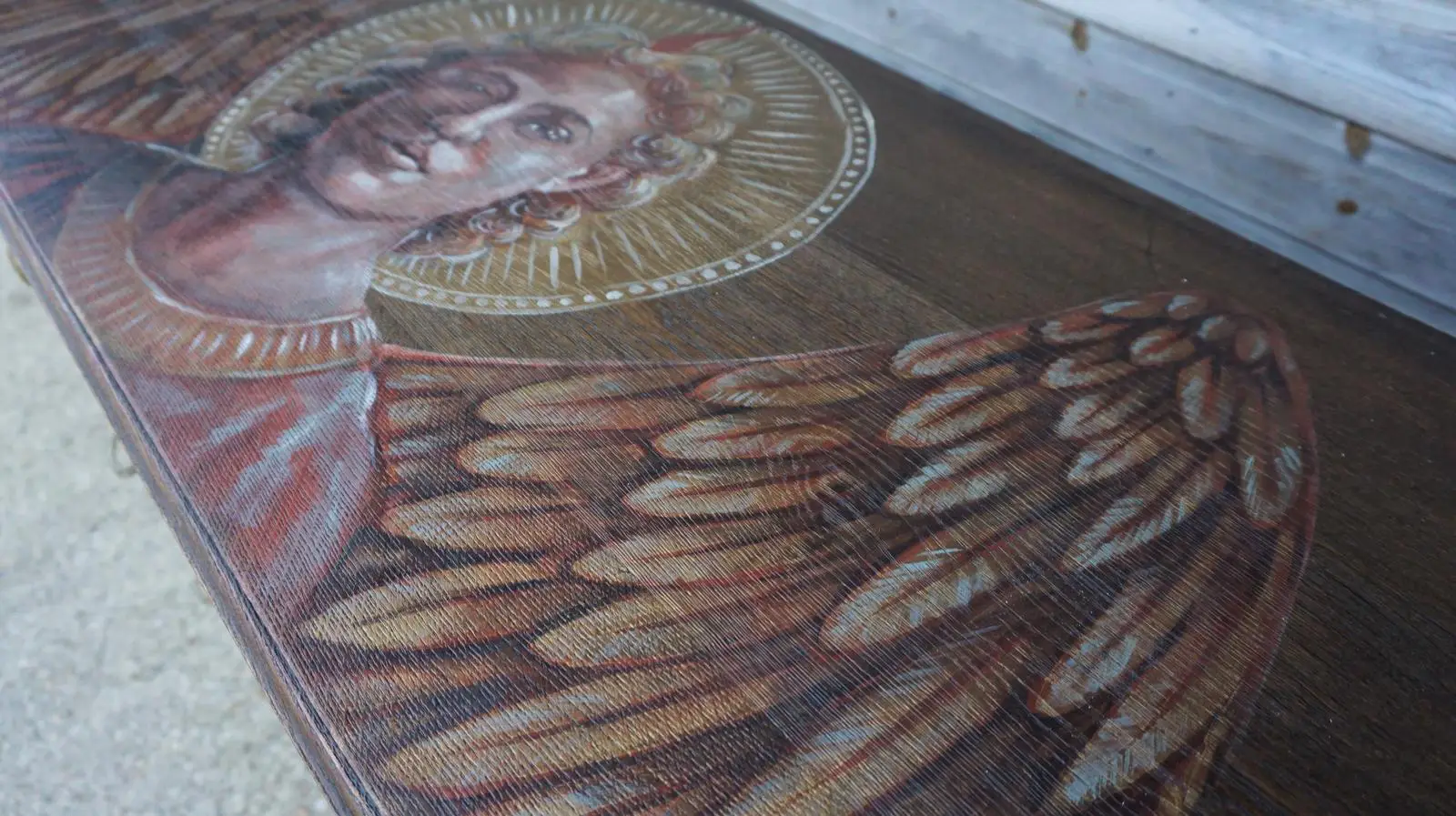Odette Gibson is founder of Daisy’s Emporium London, a boutique shop, in the vibrant Harringay area of London, bringing Odette’s popular and unique home décor and design services to the high street. Gibson and her team of dedicated artisans and designers are committed to turning clients’ dreams into reality, through personalised services and tailored solutions, including lovingly restored, hand painted furniture; grand chandeliers and fabulous lamps; curated paintings and fine art prints; upholstery, carpets and curtains; and beautiful antiques and object d’arts. We sat down with her to talk chandeliers, colour hacks, and why mood boards are magic.
London flats aren’t exactly known for their space. How can someone maximise style in a small room without making it feel cramped? Many Londoners deal with compact living spaces—what are your best hacks for creating the illusion of space?
It’s always good to have storage within a small space so make use of Alcoves. Rather than having shelves that can sometimes appear cluttered, it’s better to have a unit, And I wouldn’t build it in. I would actually buy something that’s upcycled. I’ve added things such as linen presses, because they are tall and the height gives the impression of a larger space, taking the eye up to the ceiling
Light, cool colours work well, although I’m not a particular fan of whites. I don’t think that they actually make the room look that much bigger. I know that light bounces off white but I feel that the cool, pastel colours work very well. There is some lovely furniture around. Buy a small sofa in a light grey and complement it with a small wing chair in a light pastel pink.
Mood boards seem to be a key part of your design process. What’s the best way to create one, and why is it so useful? Do you recommend physical mood boards with wallpaper and fabric samples, or are digital versions just as effective?
Some people are lucky enough to be able to walk into an empty room and visualise the finished space. They see it in their mind’s eye. For the rest of us poor mortals, who don’t really have an idea of that finished look, the secret is to use a mood board.
The easy way to put together a mood board is just to get a piece of board – it doesn’t have to be an artist board – it can be any old large-ish piece of cardboard. Just paint it white and you now have a clean canvas.
Once you have your board, go through as many lifestyle and home decorating magazines as possible and just tear out the pages that you like, be it colour or fabric, or anything that inspires you. Whittle down your pile until you are happy with your focus and potential overall look. Then pin those on your board.
Do the same thing with wallpapers to focus your look and colour. Feature walls look great and can allow something bold without being overwhelming.
Wallpaper samples and paint swatches—how essential are they when planning a room makeover? What’s your advice for pairing wallpapers with the perfect paint shades?
Never buy wallpaper directly from the internet without having a physical sample, because there’s always a subtle difference in colour. When you’ve decided on the wallpaper you want, take that along to a hardware shop and they will mix the exact paint colour to match the paper. In this way you can get a coherent look with the colours you love.
Let’s talk about the practical side—what are the most common mistakes people make when prepping their walls for painting? What’s a “mist coat,” and why is it such an important step in getting a flawless finish?
Make sure the person undertaking the redecorating (which might well be you, as it always is in my case) preps the room properly. Preparation is key; you cannot skimp on this. The most important part of the decorating process is: preparation, preparation, preparation. Without good preparation you will not achieve a beautiful finish.
Top Preparation Tips
1) Remember to thoroughly sand any woodwork you are painting. It is also a good idea to give it an undercoat – but be sure to choose the correct undercoat for the top coat paint you will be using.
2) Get to know the difference between the types of paints that are available. For example, oil-based versus water-based paints. The choice you make will affect the final finish, and should be used for different jobs. There are no hard and fast rules and which paint you use will depend on the finish you require, how long you want the job to take, and so on. So, do your research or, if in doubt, ask an expert. For example, oil-based paints are harder wearing, but cleaning your brushes is much quicker and easier with water-based paints. For most walls, a water-based paint is ideal, but for woodwork you may want to think about oil-based. Also look at the different finishes; matt, silk, satin, gloss, suede, etc. Which do you prefer? What’s right for the room, the area being painted and your lifestyle? Washable, hard-wearing paints are good for high traffic areas or if you have children or pets, for example. Silk and satin finishes reflect the light, matt works well for richer colours. Again, there are no hard and fast rules – it’s all about personal preference.
3) If the walls are in a really bad way, they will first need to be replastered by a professional. However, if they just have blemishes, a few cracks with small holes and dents, then you can probably get away with just filling in the blemishes. If the wall has had water damage or black mould in the past, you may need to put a specialised undercoat on first. Your local hardware store should be able to advise you.
Once your preparation is complete, the next step is something that all professionals follow; it is called a mist coat. That’s 50% water and 50% emulsion paint. If you are painting straight onto the plaster, it’s imperative that you do a mist coat fist which, when dried, will highlight the areas to be filled and sanded.
Many Londoners rent their homes, meaning bold design choices might not be an option. How can renters refresh a space without making permanent changes? Are there any stylish yet temporary updates that can transform a room without upsetting a landlord?
If you wish to make your rooms look and feel as luxurious as possible, without physically altering a space, soft furnishings are a great option. This could be cushions, rugs, wall-hangings and/or curtains. They can give a luxurious, or utilitarian feel – depending on what you are aiming for.
Lighting can completely change the mood of a room. What are your top tips for getting it just right? Are there any lighting trends right now that can instantly elevate a space?
Lighting is hugely important. Think about what the room will be used for, as this will influence your lighting decisions. Do you want bright light in a kitchen for example? Or mood lighting in a lounge? How about softer lighting in the bedroom with a brighter bedside table light for reading? Think about how you intend to live in the room. My advice is to have at least three to four lamps of different sizes. Lamps have the potential to look like architectural features rather than just lamps and don’t ever be put off by chandeliers – they look wonderful – even in the kitchen.
London has incredible flea markets and antique shops. What should people look for when shopping for vintage furniture or statement pieces? Do you have any favourite hidden gem locations for sourcing unique home décor in the city?
Always look for quirky, unusual and different things. Try to buy original pieces, whether it’s artwork or a Buddha head. If you buy old pieces, do not repaint them until you know what you’ve bought. I bought some very large French church angels that were candlesticks and somebody told me I should repaint them. I was horrified, because the minute you do that, they can lose their value. That’s why you have to be careful when you spend a lot of money on items. For upcycled items, spend as little as possible on an old piece of brown furniture. Also, old chandeliers are always worth looking at, as are French armoires (freestanding French wardrobes).
Portobello Road is always worth having a mooch around, as is Daisy’s Emporium, of course.
Your work at Daisy’s Emporium is all about blending the old with the new. What’s your secret to mixing vintage and modern styles effortlessly? What should people look for when shopping for antiques or statement pieces to complement a contemporary home?
Hallways always look fantastic with large gilt mirrors. Especially if it’s a narrow hallway, because the light bounces backwards and forwards between the mirrors.
Old chandeliers work really well in modern kitchens, as does a hand painted linen press, which can be used as a pantry.
Spend as much as you can afford on old pieces, they normally retain their value





